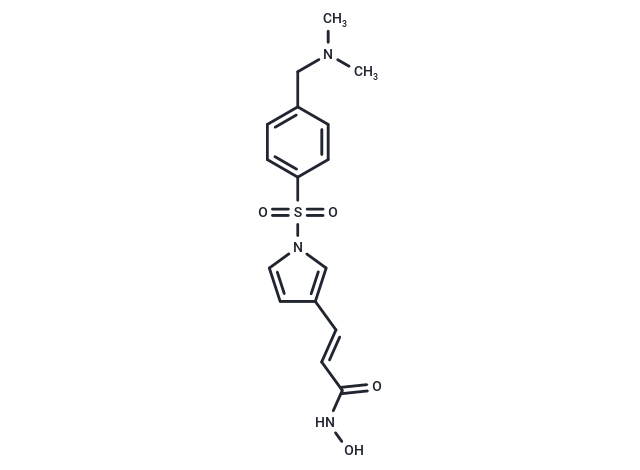Shopping Cart
- Remove All
 Your shopping cart is currently empty
Your shopping cart is currently empty

Resminostat (4SC-201) is an orally bioavailable inhibitor of histone deacetylases (HDACs) with potential antineoplastic activity.

| Pack Size | Price | Availability | Quantity |
|---|---|---|---|
| 2 mg | $55 | In Stock | |
| 5 mg | $98 | In Stock | |
| 10 mg | $180 | In Stock | |
| 25 mg | $321 | In Stock | |
| 50 mg | $577 | In Stock | |
| 1 mL x 10 mM (in DMSO) | $98 | In Stock |
| Description | Resminostat (4SC-201) is an orally bioavailable inhibitor of histone deacetylases (HDACs) with potential antineoplastic activity. |
| Targets&IC50 | HDAC6:71.8 nM, HDAC1:42.5 nM, HDAC3:50.1 nM |
| In vitro | Resminostat exhibits a favorable pharmacokinetic (PK) profile with high bioavailability and low intersubject variability in plasma concentration over time (low pT variability). The apparent half-life (t 1/2) of orally administered Resminostat ranges between 2.7 to 4.4 hours. A once-daily oral dose of 600 mg Resminostat is well-tolerated for 1-5 days within a 14-day cycle. |
| In vivo | Resminostat activates Caspases 3, 8, and 9, and synergizes with Melphalan and Proteasome inhibitors bortezomib and S-2209. Resminostat [HCl] highly acetylates histone H4 in MM cells. It inhibits cell growth and strongly induces apoptosis in MM cell lines (OPM-2, NCI-H929, U266) and primary MM cells consistently. At 1 μM, Resminostat inhibits cell proliferation and induces G0/G1 cell cycle arrest in MM cell lines (OPM-2, NCI-H929, U266), accompanied by decreased levels of cyclin D1, CDC25A, CDK4, and Rb and upregulation of the p21 gene. It interferes with the Akt signaling pathway by reducing the phosphorylation of 4E-BP1 and p70S6K. Additionally, Resminostat increases the expression levels of Bim and Bax proteins while decreasing the level of Bcl-xL. |
| Kinase Assay | Enzymatic HDAC activity assays: 40 μL enzyme buffer (15 mM Tris HCl pH 8.1, 0.25 mM EDTA, 250 mM NaCl, 10% v:v glycerol) containing HDAC1, 3, 6 or 8 activity, 29 μL enzyme buffer and 1 μL resminostat at different concentrations are added to a 96-well microtitre plate and the reaction started by the addition of 30μL substrate peptide Ac-NH-GGK(Ac)-AMC (HDAC1, 3 and 6 assays, final concentrations 6 μM for HDAC1, 10 μM for HDAC6 and 25 μM for HDAC3/DAD) or Ac-RHK(Ac)K(Ac)-AMC (HDAC8 assay, final concentration 50 μM). After incubation for 3 hours (HDAC1, HDAC6, HDAC8) or 2 hours (HDAC3) at 30°C, the reaction is terminated by the addition of 25 μL stop solution (50 mM Tris HCl pH 8, 100 mM NaCl, 0.5 mg/mL trypsin and 2 μM trichostatin A [TSA]). After incubation at room temperature for further 40 min, fluorescence is measured using a multilabel counter (extinction 355 nm, emission 460 nm) for quantification of AMC generated by tryptic cleavage of the deacetylated peptide. For the calculation of the IC50, the fluorescence in wells without test compound (1% DMSO, negative control) is set as 100% enzymatic activity and the fluorescence in wells with 2 μM TSA (positive control) is set at 0% enzymatic activity (background fluorescence substracted). |
| Cell Research | Cell lines: OPM-2,NCI-H929,RPMI-8226 and U266. Concentrations: ~ 10 μM. Method: WST-1 assay |
| Alias | RAS2410, 4SC-201 |
| Molecular Weight | 349.4 |
| Formula | C16H19N3O4S |
| Cas No. | 864814-88-0 |
| Relative Density. | 1.28 g/cm3 (Predicted) |
| Storage | store at low temperature | Powder: -20°C for 3 years | In solvent: -80°C for 1 year | Shipping with blue ice. | |||||||||||||||||||||||||||||||||||
| Solubility Information | DMSO: 65 mg/mL (186.03 mM), Sonication is recommended. Ethanol: 65 mg/mL (186.03 mM), Sonication is recommended. H2O: <1 mg/mL | |||||||||||||||||||||||||||||||||||
Solution Preparation Table | ||||||||||||||||||||||||||||||||||||
DMSO/Ethanol
| ||||||||||||||||||||||||||||||||||||

Copyright © 2015-2025 TargetMol Chemicals Inc. All Rights Reserved.